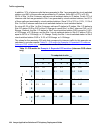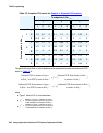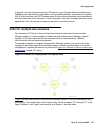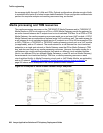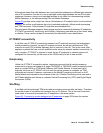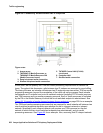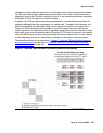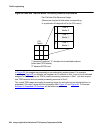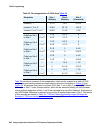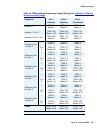
Resource sizing
Issue 6 January 2008 201
Although we stated that calls between two circuit-switched endpoints on different port networks
use an IP connection, the use of a circuit-switched center stage between the two PNs is also
supported. However, using circuit-switched facilities is not viable for interconnecting multiple
Media Gateways, or for interconnecting PNs and Media Gateways.
Figure 65
provides some insight into how a call between an IP endpoint and a circuit-switched
endpoint, as well as a call between two circuit-switched endpoints, utilizes media processing
and TDM resources. Calls between IP endpoints are addressed first.
Communication Manager supports three general modes of connectivity between IP endpoints:
IP-TDM-IP connectivity, hairpinning, and shuffling. Hairpinning can take one of two forms: deep
or shallow. These various modes of connectivity are described in more detail below.
IP-TDM-IP connectivity
A call that uses IP-TDM-IP connectivity between two IP endpoints requires one bidirectional
media processing “channel” for each IP endpoint involved, as well as a bidirectional TDM
resource on every PN (or Media Gateway) that is involved in the call. This option most often
applies in systems that use a circuit-switched center stage for interport network connectivity. In
such a system, IP-TDM-IP is required in order for two IP endpoints in network regions not
configured for connectivity (in the sense of the IRCM matrix) to talk to one another.
Hairpinning
Unlike the IP-TDM-IP connectivity option, hairpinning requires that all media processing
resources for a given call reside on a single TN2302AP or TN2602AP media processing circuit
pack or a single G350 or G700 Media Gateway VoIP Media Module. A hairpinned call is
originally set up as an IP-TDM-IP call, but once the set-up process is complete, no TDM
resources are required. However, resources on the Media Processing circuit pack or VoIP
Media Module are required for the duration of the call. A Media Processing circuit pack and a
VoIP Media Module each house an onboard Central Processing Unit (CPU) and Digital Signal
Processors (DSPs).
Shuffling
A shuffled call relinquishes all TDM and media processing resources after call setup. Therefore,
the media stream of a shuffled call traverses only an IP network. This is the most commonly
used mode of connectivity between two IP endpoints in the same system.
Figure 66:
Connectivity modes between two IP endpoints on page 202 shows the various
modes of connectivity between two IP endpoints.




